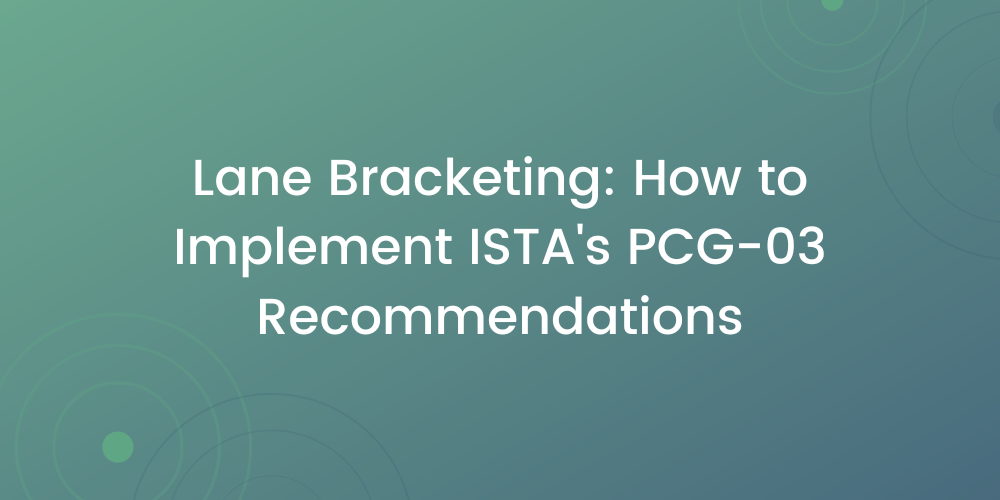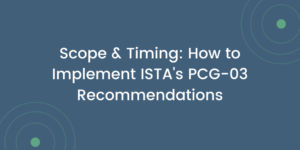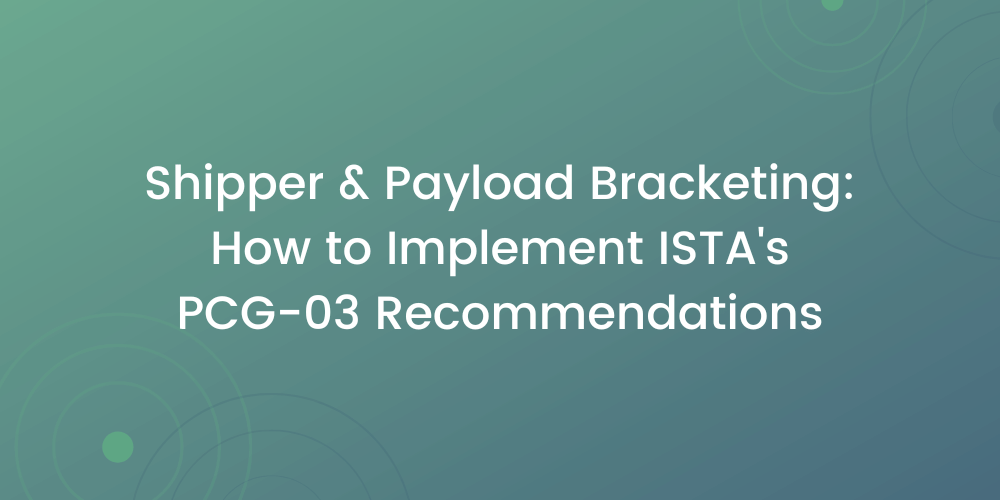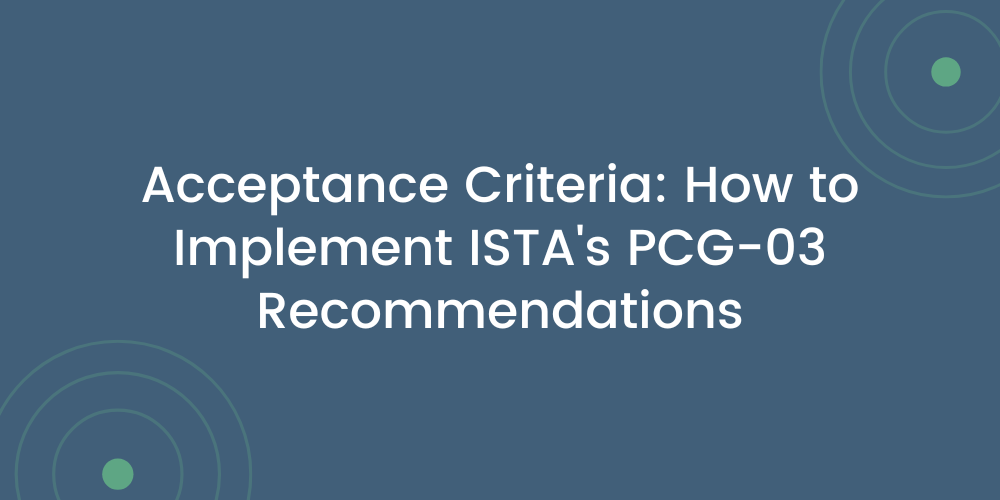Lane Bracketing: How to Implement ISTA’s PCG-03 Recommendations
On July 22nd, 2022, ISTA released PCG-03: Performance Qualification (PQ) and Performance Verification (PV)...
read Details

On July 22nd, 2022, ISTA released PCG-03: Performance Qualification (PQ) and Performance Verification (PV) Best Practice Guideline. PCG-03 takes the first steps toward standardizing best practices for PQ strategy and execution for the biopharmaceutical industry, as it is the first document to compile strategies from thought leaders in the industry and provide a path forward for transport validation work.
We applaud ISTA for this useful and comprehensive list of considerations for determining your PQ strategy. However, there remains a clear gap on how to manage and implement their recommendations. The items listed within the document require further context to enable the industry to form a cohesive approach to PQ strategy.
This article series will seek to dive deep into the considerations listed by ISTA and discuss the implications and risks of each topic. Each article will contain a recommended tactical approach to each of these considerations:
As each article is released, we will link it in the Table of Contents above so you can navigate to each topic. In this article, the experts at Modality Solutions are diving into the Scope & Timing recommendations found in PCG-03.
Before designing a testing protocol for PQ execution, the scope and timing of your PQs must be well understood. Defining the scope and timing is critical for both strategy development and the overall success of your PQ program. Conducting PQs too early may fail to test the process in its steady state. Testing too late may delay the shipments of material or even your commercial filings. We recommend testing in the actual commercial lanes once they are defined.
The first step in designing a PQ strategy is understanding where PQs fit into process validation. Thermal packaging is qualified in two steps: Operational Qualification (OQ) and PQ. In short, OQs qualify the equipment (i.e., thermal shipper), whereas PQs qualify the process.
OQs are lab studies that determine unit performance at the extremes of the operating space. Shipper performance is tested against the various worst-case conditions: extreme hot and cold ambient conditions, minimum and maximum load, and an adequate number of temperature monitors to explore hot/cold spots within the unit. OQ strategy has been well covered by ISTA in Standard 20 and PCG-02.
PQs, however, focus on testing the interaction between the qualified thermal shipper and the real-world shipping process. PCG-03 states that a PQ is “intended to verify the performance capability of the designed thermal shipping system . . . with actual transportation and logistics service provider(s).”
PQs do not need to test extremes, as you simply verify shipper performance. PQs need to be realistic representations of your shipping process and the use of a thermal shipper. They do not, therefore, require worst-case conditions during execution. There is no need to guess the weather before executing your PQ!
As worst-case conditions are not required during PQ execution, seasonality does not need to be represented in PQs. Seasonality has been historically executed to demonstrate the performance of the shipping system in summer versus winter conditions or when shipping to a warm or cold temperature location. However, a valid OQ should have already subjected the shipping system to hot and cold extremes before your PQ. Furthermore, external conditions cannot be controlled during real-world studies; you may have unseasonal weather during your seasonal executions. The results of hot and cold studies during OQ testing should be leveraged in place of seasonal PQs.
The exception is when shippers with a seasonal packout are used/prepared differently depending on the time of year. For example, certain shipper models will have two different packout presentations, with varying amounts or conditions of gel packs. The specific packout presentation may switch depending on weather conditions or by date. Each unique packout presentation for the shipper must be tested under their respective situations in these specific cases.
PQ timing is also a key consideration for design and execution. Timing can be broken down into two categories: concurrent and prospective.
Concurrent execution uses actual product shipments once the final process is fully in place. For example, this may be shipments from a distributor to pharmacies using the first commercial shipments after approval. The PQ study is executed concurrently with the first product shipments.
Prospective execution occurs before process finalization and may or may not use the actual product. Prospective studies occur in parallel with the development of the final shipping process.
Each method has advantages. The main advantage of prospective PQ studies is timeliness; you do not need to wait until all pieces of the process are final to gather data. Secondly, executing prior to first product shipments allows for process troubleshooting before actual product may be at risk.
Concurrent PQ studies have the advantage of studying the final shipping process. Executing concurrent with first product shipments ensures that you are testing final working documentation such as work instructions and SOPs.
The status of SOPs is crucial to PQ execution regardless of whether you are executing concurrent or prospective PQs. As PQs focus on the performance of the shipping process, it is imperative that the process during PQ execution matches the day-to-day process.
PQs can result in the development, update, and/or confirmation of shipping SOPs. These SOPs must be in place post-PQ to ensure that the thermal shipping process operates in a state of control. The SOPs do not need to be in final approved form to execute the PQ. If the SOP is in draft form, the PQ should be designed to accurately reflect the expected process. Otherwise, the SOP can be drafted and implemented following the exact procedure executed in the PQ. Either way, the SOP should be effective following a successful PQ.
In summary, PQs are executed to verify shipper performance, not to test the limits of performance. This means that seasonality and other extremes tested in an OQ do not need to be included in your PQs, greatly simplifying the scope of the studies. Additionally, we recommend concurrent PQ studies in your defined commercial shipping lanes. Executing PQs with first commercial shipments ensures that the shipping process is final including all supporting SOPs.
With timing and scope defined, you can now begin designing your PQ strategy and applying it to your various shipping lanes. The growing complexity of biopharmaceutical supply chains means that determining which lanes to execute your studies in is a challenge in its own. The next article will explore lane bracketing in PQs: how to cover multiple shipping lanes under a single PQ.
Modality Solutions is a leading provider of innovative and comprehensive solutions for the biopharmaceutical industry. Our team of experts has extensive experience in the industry and works closely with national and international regulators to ensure that our clients stay ahead of the latest industry developments and best practices. We pride ourselves in providing tailored solutions to meet the unique needs of our clients, and we are committed to helping organizations achieve their PQ goals. Contact us for more information on how we can help your organization navigate the complex world of biopharmaceutical transportation. And don’t forget to follow us on LinkedIn to stay updated on our latest developments.
On July 22nd, 2022, ISTA released PCG-03: Performance Qualification (PQ) and Performance Verification (PV)...
read Details
On July 22nd, 2022, ISTA released PCG-03: Performance Qualification (PQ) and Performance Verification (PV)...
read Details
On July 22nd, 2022, ISTA released PCG-03: Performance Qualification (PQ) and Performance Verification (PV)...
read Details